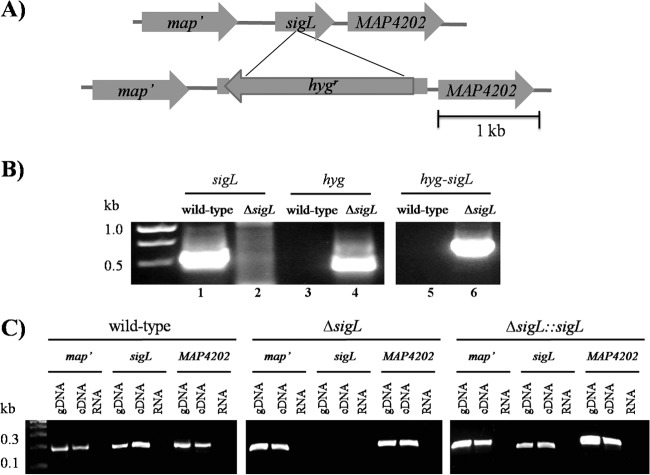FIG 1.
Construction of M. avium subsp. paratuberculosis ΔsigL using wild-type M. avium subsp. paratuberculosis strain. (A) Physical map displaying the deletion of sigL (MAP4201) gene with homologous recombination via pYUB854 cosmid shuttle cloning vector, which resulted in the deletion of an ∼750-bp coding region and the insertion of an ∼2-kb region carrying a hygromycin resistance cassette. (B) The M. avium subsp. paratuberculosis ΔsigL mutant was confirmed with PCR and sequence verification using genomic DNA from the wild-type and the mutant strains. Primer pairs were designed for the sigL region, the hygromycin resistance gene (hyg), or the recombinant region after allelic exchange. A 1.5% agarose gel showed amplicons from the sigL region only when wild-type genomic DNA was used (lane 1), whereas hyg was amplified only from the M. avium subsp. paratuberculosis ΔsigL mutant genomic DNA (lane 4). Lane 6 showed amplicon from the recombinant region only when M. avium subsp. paratuberculosis ΔsigL mutant genomic DNA was used. (C) The polarity of the M. avium subsp. paratuberculosis ΔsigL mutant was assessed using reverse transcriptase PCR analysis to check for transcription of its neighboring genes. In the wild-type (left) and complemented (right) strains, positive bands show that map′, sigL, and the downstream gene MAP4202 are present in the genome and transcribed (amplified from cDNA), with no amplification from RNA used as a negative control. In the M. avium subsp. paratuberculosis ΔsigL mutant (middle), the sigL coding region is absent in the genome and as cDNA, but transcripts for the neighboring genes are present.

